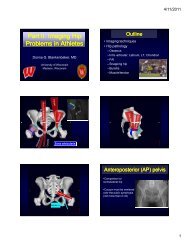Ankle and Foot 47 - Department of Radiology - University of ...
Ankle and Foot 47 - Department of Radiology - University of ...
Ankle and Foot 47 - Department of Radiology - University of ...
You also want an ePaper? Increase the reach of your titles
YUMPU automatically turns print PDFs into web optimized ePapers that Google loves.
2260 VII Imaging <strong>of</strong> the Musculoskeletal System<br />
A<br />
B<br />
Figure <strong>47</strong>-67. Acute talar dome fracture in<br />
a 23-year-old who fell from a ladder. A <strong>and</strong> B,<br />
Anteroposterior <strong>and</strong> mortise radiographs in which the<br />
cortical fracture <strong>of</strong> the lateral corner <strong>of</strong> the talar dome<br />
is so nondisplaced it is barely discernible (arrow). C<br />
<strong>and</strong> D, Mortise coronal CT images obtained the same<br />
day well demonstrate the cortical fragment (arrow) as<br />
well as the full extent <strong>of</strong> the fracture (arrowheads).<br />
C<br />
D<br />
<strong>Radiology</strong> <strong>and</strong> Computed Tomography<br />
Although the development <strong>of</strong> a symptomatic OLT can<br />
<strong>of</strong>ten be traced to a specific injury, radiographs are usually<br />
read as normal early on. In part, this is because many <strong>of</strong><br />
these fractures are so nondisplaced that they can be difficult<br />
to see radiographically (Fig. <strong>47</strong>-67). But sometimes,<br />
even in retrospect, the initial radiographs truly are negative,<br />
<strong>and</strong> it may take months for the OLT to be radiographically<br />
apparent (Fig. <strong>47</strong>-68). At the UW we have a special<br />
reformatting protocol just for such talar dome fractures<br />
(see Fig. <strong>47</strong>-<strong>47</strong>A) that includes 1-mm-thin slices reformatted<br />
with no gaps in the mortise coronal <strong>and</strong> mortise sagittal<br />
planes.<br />
Magnetic Resonance Imaging <strong>and</strong> Staging<br />
Although CT is good at showing a displaced fragment <strong>and</strong><br />
the size <strong>of</strong> the talar dome defect, MRI is better at showing<br />
the integrity <strong>of</strong> the overlying articular hyaline cartilage<br />
<strong>and</strong> the underlying bone marrow. Edema-sensitive MRI is<br />
used to detect OLTs that are radiographically occult <strong>and</strong><br />
also is used to stage known OLTs to assess for healing<br />
potential or need for surgery.<br />
Several staging systems have been proposed. In 1959,<br />
Berndt, 8 an orthopedic surgeon from the Clevel<strong>and</strong> Clinic,<br />
working with Harty, an anatomist from the <strong>University</strong> <strong>of</strong><br />
Pennsylvania, analyzed 24 cases <strong>of</strong> what they called “transchondral<br />
fractures <strong>of</strong> the talus.” In the process <strong>of</strong> tabulating<br />
their data, “an arbitrary classification was developed to<br />
aid underst<strong>and</strong>ing <strong>of</strong> the mechanism <strong>of</strong> the fracture <strong>and</strong><br />
to help in determining the appropriate treatment.” This<br />
staging system was based solely on the radiographic appearance<br />
<strong>of</strong> the fracture:<br />
Stage I: A small compression fracture<br />
Stage II: Incomplete avulsion fragment<br />
Stage III: Complete avulsion without displacement<br />
Stage IV: Avulsed fragment displaced within the joint<br />
Thirty years later, Anderson <strong>and</strong> colleagues 2 from Australia<br />
modified this staging system based on the MRI<br />
appearance <strong>of</strong> the fracture. Anderson called stage I “subchondral<br />
trabecular compression” <strong>and</strong> defined it as radiographically<br />
negative, but with bone marrow edema on MRI<br />
(Fig. <strong>47</strong>-69). Anderson called stage II “incomplete separation<br />
<strong>of</strong> the fragment,” requiring demonstration <strong>of</strong> an intact<br />
attachment by either CT or MR (Fig. <strong>47</strong>-70). Anderson<br />
added a stage IIA, “formation <strong>of</strong> a subchondral cyst” (Fig.<br />
<strong>47</strong>-71). Stage IIA cysts are thought to develop from stage I<br />
injuries with post-traumatic necrosis <strong>of</strong> bone <strong>and</strong> subsequent<br />
resorption <strong>of</strong> the necrotic trabeculae, leaving behind<br />
a subchondral cyst. Anderson stage III, “unattached, undisplaced<br />
fragment,” is the same as Berndt <strong>and</strong> Harty stage III.<br />
Anderson noted, “In the T2 weighted image, the presence<br />
<strong>of</strong> synovial fluid around a large fragment can help to differentiate<br />
between stages II <strong>and</strong> III.” However, Anderson<br />
went on to question the utility <strong>of</strong> MRI over CT in making<br />
this determination (Fig. <strong>47</strong>-72). Anderson stage IV, “displaced<br />
fragment,” is the same as Berndt <strong>and</strong> Harty stage IV<br />
(Fig. <strong>47</strong>-73).<br />
Around the same time as Anderson but half a world<br />
away, De Smet <strong>and</strong> coworkers 19 from the <strong>University</strong> <strong>of</strong><br />
Wisconsin, Madison, were correlating surgical <strong>and</strong> MRI<br />
findings <strong>and</strong> dividing OLTs into stable or unstable lesions.<br />
Stable fragments were defined as being fixed firmly<br />
with fibrous tissue or fibrocartilage, <strong>and</strong> these patients<br />
were thought not to need surgery. Unstable fractures are<br />
those that can be shown by MRI to be partially attached or<br />
unattached, <strong>and</strong> these fractures were thought to require<br />
more aggressive treatment with surgery or prolonged<br />
immobilization. De Smet showed that the key factor in<br />
distinguishing stability from instability by MRI is the<br />
presence <strong>of</strong> bright signal on T2-weighted images at the<br />
interface between the fragment <strong>and</strong> the donor site. In unattached<br />
fragments this signal was as bright as fluid, <strong>and</strong><br />
surgery confirmed that these fragments were surrounded<br />
Ch0<strong>47</strong>-A05375.indd 2260<br />
9/9/2008 5:34:57 PM
















